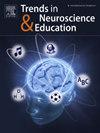Autonomic stress responses in oral examination simulations: Neuroscientific insights from comparing peer-led and lecturer-led approaches
IF 3
Q2 NEUROSCIENCES
引用次数: 0
Abstract
It is well established in cognitive psychology that stress impairs the retrieval of stored information, often leading to the phenomenon commonly known as a 'blackout' during high-stakes oral examinations. Thus, this mixed-methods study investigated how peer-led and lecturer-led oral examination simulations impact physiological stress responses and students’ self-perceptions. Using heart rate variability (HRV) markers (RMSSD, pNN50, SDNN, LF/HF), we assessed autonomic activation during the simulations. Linear Mixed Models (LMMs) revealed a significant effect of the exam condition on HRV parameters (RMSSD: β = -14.16, p < .001; LF/HF: β = 19.52, p < .001), indicating reduced parasympathetic activation in both simulation types. However, lecturer-led simulations elicited a stronger sympathetic shift (LF/HF interaction: β = -19.33, p < .001), suggesting a higher stress response than peer-led simulations.
Students' competence and confidence significantly improved post-simulation (lecturer-led: t = -8.41, p < .001; student-led: t = -5.82, p < .001), while test anxiety significantly decreased after participating in the simulation (p < .05). Qualitative follow-up data supported the perceived value of simulations for exam preparation and provided insights into the underlying emotional dynamics.
These findings suggest that peer-led simulations may offer a scalable, resource-efficient alternative to lecturer-led training. The positive results highlight the potential of integrating peer-led simulations longitudinally and encourage further research on their cumulative effects over multiple exam cycles.
口语考试模拟中的自主应激反应:从比较同伴主导和讲师主导方法的神经科学见解
认知心理学已经证实,压力会削弱对存储信息的检索,通常会导致在高风险的口试中出现通常被称为“记忆中断”的现象。因此,这项混合方法的研究调查了同伴主导和讲师主导的口试模拟如何影响生理应激反应和学生的自我认知。利用心率变异性(HRV)标记(RMSSD、pNN50、SDNN、LF/HF),我们评估了模拟过程中的自主神经激活。线性混合模型(lmm)显示,测试条件对HRV参数有显著影响(RMSSD: β = -14.16, p <;措施;LF/HF: β = 19.52, p <;.001),表明两种模拟类型的副交感神经激活都减少了。然而,讲师主导的模拟引发了更强的交感神经移位(LF/HF相互作用:β = -19.33, p <;.001),这表明与同伴主导的模拟相比,压力反应更高。模拟后学生的能力和信心显著提高(讲师主导:t = -8.41, p <;措施;学生主导:t = -5.82, p <;.001),而参加模拟后考试焦虑显著降低(p <;. 05)。定性随访数据支持了模拟考试准备的感知价值,并提供了对潜在情绪动态的见解。这些发现表明,同伴主导的模拟可能为讲师主导的培训提供一种可扩展的、资源高效的替代方案。积极的结果突出了纵向整合同行主导模拟的潜力,并鼓励进一步研究它们在多个考试周期中的累积效应。
本文章由计算机程序翻译,如有差异,请以英文原文为准。
求助全文
约1分钟内获得全文
求助全文
来源期刊

Trends in Neuroscience and Education
NEUROSCIENCES-
CiteScore
6.30
自引率
6.10%
发文量
22
审稿时长
65 days
 求助内容:
求助内容: 应助结果提醒方式:
应助结果提醒方式:


